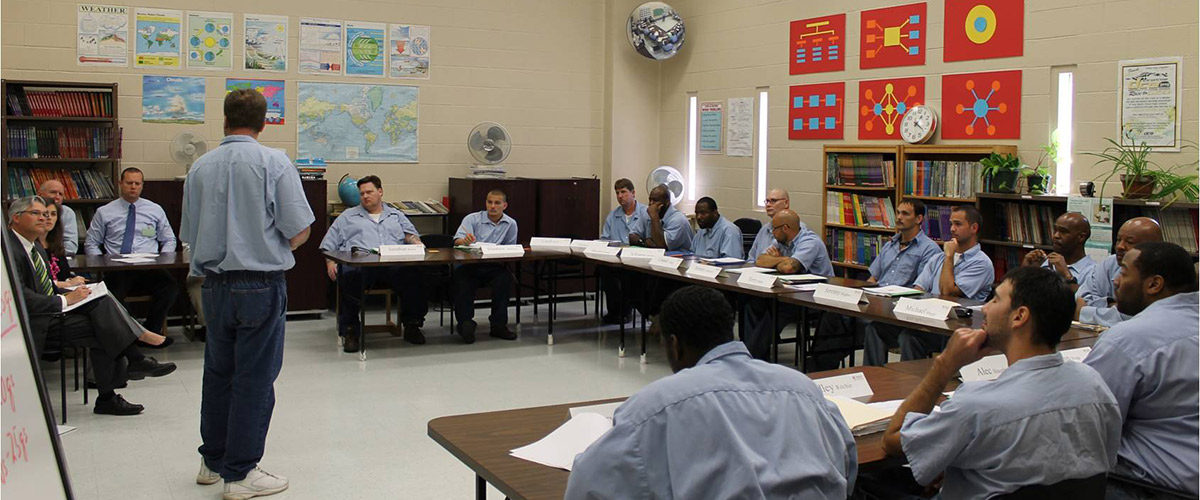Costs Pretrial Services Reentry January 21, 2016
Providing programs in jail that teach job skills and prepare inmates for employment will reduce the chance that they will return after they are released—saving money in the long run and improving public safety. However, meaningful inmate programming can be costly. Creative use of existing staff and vendors can, nonetheless, yield impressive results, as we found in Milwaukee.
The Milwaukee County House of Correction (HOC), which supervises most of the county’s sentenced population, historically has not offered any substantial inmate educational activities, pre-employment programming, or job training. When County Executive Chris Abele took over management of the HOC in May of 2013 and began working with advocates and experts across the criminal justice system, the HOC was able to implement several programs that give inmates a chance to break the cycle of incarceration and give back to the community.
Although some of the inmate programming activities implemented at the HOC since May of 2013 are paid through the HOC operations budget, many were established by using the expertise and dedication of existing staff, leveraging vendor contracts, and by partnering with community groups. These programs use a small amount of the budget, but provide a significant impact that can assist inmates to become more employable and prepared for reentry upon release.
When using vendor contracts and staff roles to build new programs, it can be particularly effective to involve staff or vendors in the development of a program from the beginning. The Preparation for Success Program, a six-week pre-employment training program implemented in late 2014, was conceived, developed, and implemented by an HOC programs officer. Our program officers typically schedule events or presenters, supervise inmates on work crews, escort them to activities, and make sure programs run on time, in addition to being available for various other tasks as needed. The Preparation for Success program is presented as part of these regular duty activities and only requires a small amount of materials, but successfully promotes self-esteem, empowerment, and confidence by assisting inmates in practical job preparation skills such as filling out applications or drafting cover letters and resumes.
In another case, during a process to hire a vendor to run foodservice operations at the HOC, each vendor was required as part of their bid to propose a culinary job training program for inmates at no cost to the HOC (i.e., the cost of the program would not be paid through a portion of fees paid to the vendor). The successful bid vendor proposed—and has been conducting—a nationally recognized restaurant and food safety training and certification program for the inmates, IN2WORK, since January of 2014.
Other programs do require dedicated financial support, but it can often be obtained by a combination of grants, community partnerships, and small initial investments from existing budgets. For example, the Home2Stay program provides job training in welding, applied mathematics, and machining through a United States Labor Department grant obtained by Word of Hope Ministries. The HOC assists with the screening of participants and provides transportation for inmates to the instruction and training sites.
Earlier this year, the HOC established a Vermiculture operation—or worm farm—on HOC grounds. The program produces worms to feed reptiles at the Milwaukee County Zoo as well as worm casings to be used as organic fertilizer by groups such as local garden organizations. It develops job training skills, demonstrates entrepreneurship, and provides inmates with an opportunity to give back to the community and make productive use of their time during confinement. The HOC made an initial purchase for supplies and stock from existing programming funds to get the program started, but after that, a portion of the casings that the worms produce are exchanged with a vendor for fresh materials for further processing at no cost to the HOC.
Through the dedication of HOC staff as well as the collaboration of justice system stakeholders, advocates, community organizations, and businesses, in less than three years we have been able to grow from virtually no substantive programming to offering dozens of programs that provide meaningful reentry support, with nearly 78% of eligible inmates involved in at least one (all inmates who are sentenced to the HOC are eligible). We now look forward to making other collaborative changes to the way we use the HOC as one of the jurisdictions selected to participate in the MacArthur Foundation’s Safety and Justice Challenge, a national initiative to change the way America thinks about and uses jails. As our experience shows, budget concerns in strapped local jails across the country should not prevent the development of reentry programming, but encourage it, as creative collaboration will result in supportive options for individuals that can reduce recidivism, improve public safety, and save costs.







